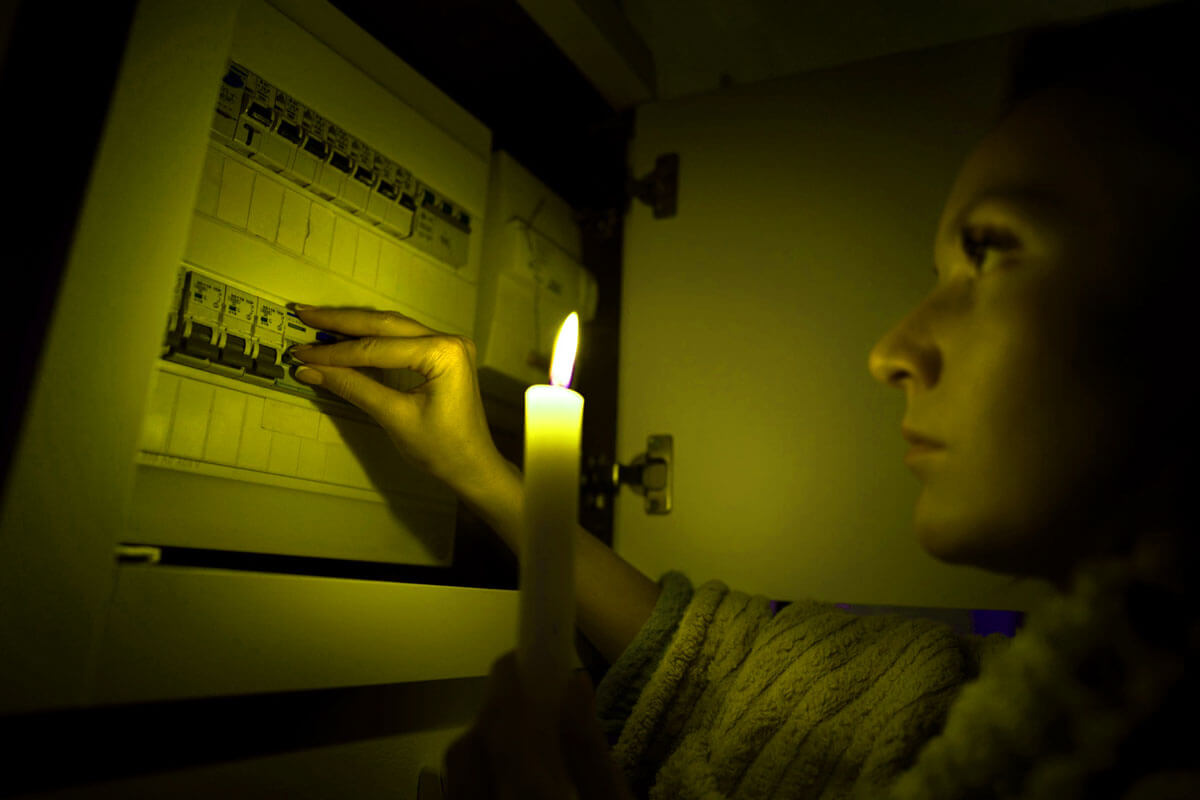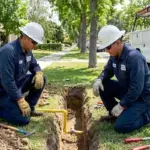Electrical problems in house situations affect millions of homeowners each year and cause more than 51,000 house fires annually, according to 2025 data from the Electrical Safety Foundation International. From flickering lights and hot outlets to overloaded circuits and outdated wiring, these electrical faults range from minor inconveniences to serious electrical hazards. Understanding the warning signs and knowing when to call a professional can protect your family and prevent costly damage to your home.
Recognizing Warning Signs Early
Your home gives you clear signals when electrical malfunctions develop. Most residential electrical systems show warning signs before they become dangerous electrical hazards.
Hot outlets or switch plates signal immediate trouble. Even appliances that produce heat should never make their outlets warm to touch. Circuit breaker tripping frequently points to overloaded circuits or faulty wiring defects. Burning smells near outlets or electrical panels demand instant attention and often indicate fire risk—a critical concern since electrical distribution systems are the third leading cause of home structure fires.
Flickering lights usually mean loose connections rather than ghostly visitors. This common symptom often indicates problems within the broader building electrical networks. One flickering fixture suggests a simple problem, but multiple lights flickering throughout your house indicates bigger circuit or panel issues. Buzzing or crackling sounds from outlets, switches, or panels aren’t normal and need professional inspection to prevent power failures.
Discoloration or scorch marks around outlets show that wiring has been damaged and heat is escaping. Mild electrical shocks when touching appliances or metal fixtures suggest ground fault protection problems. These shocks differ from harmless static electricity and require immediate attention to maintain electrical safety.
Common Electrical Faults: Causes and Symptoms
Loose wiring creates the most common and dangerous electrical problems. Connections loosen over time due to thermal expansion, vibration, or poor initial installation—issues that can affect any part of your home’s electrical infrastructure.
Overloaded circuits happen when you plug too many devices into one circuit or when older panels struggle with modern electrical load capacity demands. Signs include dimming lights when appliances start, warm outlets, and frequent circuit breaker trips. Most older homes have 60 to 100-amp panels that can’t handle today’s electrical needs, creating systemic stress on the entire electrical system.
Outdated wiring materials like aluminum wiring or knob-and-tube wiring create safety risks that require immediate attention. Aluminum wiring, common in homes built between 1965 and 1973, expands and contracts more than copper, loosening connections over time. Research from 2025 confirms that aluminum wiring requires special connectors and devices often ignored during installations, leading to intermittent electrical problems. Knob-and-tube wiring, used from the 1880s until the 1940s, lacks grounding and modern safety features essential for electrical safety. These aging systems often create cryptic problems that appear randomly.
Short circuits occur when hot wires touch neutral wires or ground wires. This creates dangerous heat and sparks that can start fires. Arc fault circuit interrupters (AFCI) detect these conditions and shut off power before fires start—a critical safety feature now required by NEC 2023 for most living spaces.
Poor grounding systems fail to provide safe paths for electrical current during faults. Without proper grounding, metal fixtures, appliances, and pipes can become energized and shock anyone who touches them. The term “ground” itself reflects the electrical concept of providing a safe path to earth for excess electricity.
Modern Demands & Smart Home Load Stress in Older Homes
Today’s homes use far more electricity than homes built even 20 years ago. Electrical load capacity problems affect millions of older homes trying to power modern appliances and smart home technologies that create unprecedented demands on residential electrical systems.
Smart home energy management systems, while designed to improve efficiency, often reveal underlying electrical problems. These systems monitor energy consumption in real-time, frequently uncovering wiring defects and capacity issues previously hidden. Recent 2025 research shows that smart home devices create complex load patterns that older electrical distribution systems struggle to handle safely.
EV chargers represent the biggest new demand on home electrical panels. Level 2 EV chargers need 30 to 50 amps of dedicated power—a significant portion of a home’s total capacity. Homes with 100-amp panels often lack capacity for EV charging without major upgrades. Older homes with 60-amp panels definitely need electrical service upgrades before adding EV chargers, as attempting to operate beyond capacity creates dangerous conditions.
Smart home devices, multiple computers, large screen TVs, and high-efficiency heat pumps all increase electrical demand. Air conditioning systems in older homes often overload circuits designed for smaller window units. Modern kitchen appliances like induction cooktops and convection ovens need more power than older models, contributing to overloaded circuit conditions.
Surge protection becomes critical as we add more sensitive electronics to our homes. Power surges from lightning, utility switching, or large motor cycling can damage expensive equipment. Whole-house surge protectors installed at the main panel provide the best protection and are increasingly detectable through smart monitoring systems.
Load management systems help older homes handle modern demands without complete electrical upgrades. These systems monitor total household electrical use and automatically reduce EV charging speeds or delay appliance operation during peak demand periods, representing a bridge between outdated wiring and modern electrical needs.
Safety Standards & Code Requirements You Should Know
The National Electrical Code (NEC) 2023 brings major safety improvements that affect homeowners. These requirements save lives and prevent property damage while ensuring code compliance throughout residential electrical systems.
Ground fault protection requirements expanded significantly in 2023. GFCI outlets protection now covers all 120-volt and 250-volt outlets in kitchens, bathrooms, garages, basements, crawl spaces, and outdoor areas. Kitchen GFCI requirements now include all receptacles, not just countertop outlets. This means refrigerator, dishwasher, and range outlets need GFCI protection—a substantial change from previous electrical codes.
Arc fault circuit interrupters (AFCI) protection now covers virtually every living space in homes. All 120-volt, 15-amp and 20-amp circuits in bedrooms, living rooms, dining rooms, kitchens, family rooms, and most other habitable spaces need AFCI breakers. This requirement takes effect January 1, 2025, for new construction and major renovations, representing a significant advancement in electrical safety standards.
Emergency disconnects provide crucial safety features for first responders. New homes need readily accessible outdoor disconnects that allow fire fighters and EMTs to cut power from outside the building. These disconnects must be clearly marked and located away from potential fire areas—a preventable safety measure that can save lives.
Regular electrical inspections help catch problems early. Most areas require inspections only during renovations, but the Consumer Product Safety Commission recommends professional inspections every 10 years. Homes over 40 years old benefit from more frequent inspections to identify detectable problems before they become costly emergencies.
What to Do When You Find a Problem: Checking and Fixing
Electrical problems require careful assessment and often professional help. Never attempt electrical work beyond your skill level, as electrical hazards can be fatal.
Immediate Actions for Urgent Problems
Turn off power at the circuit breaker immediately when you smell burning, see sparks, or feel shocks. Unplug all devices from affected outlets and don’t use them until problems get resolved—a simple but preventable step that can prevent fires.
Call a licensed electrician right away for burning smells, hot outlets, continuous sparking, or repeated electrical shocks. These conditions can cause fires or electrocution within hours or days. Electrical contractors have specialized training to handle dangerous situations safely.
Don’t ignore circuit breaker tripping that happens repeatedly. While occasional trips indicate simple overloads, frequent tripping suggests dangerous wiring defects. Move high-power appliances to different circuits as a temporary solution, but have the system professionally inspected to ensure electrical safety.
Check circuit breakers and GFCI outlets first when outlets stop working. Reset tripped breakers by turning them fully off, then back on. Press the RESET button on GFCI outlets that have stopped working. If problems persist after resetting, call for professional help to avoid electrical fires.
Planning Upgrades & Hiring Professionals
Electrical upgrades require careful planning and professional installation. Calculate your home’s total electrical load capacity needs before adding major appliances or EV chargers to avoid power outages and ensure proper wiring.
Panel upgrades from 100-amp to 200-amp service typically cost $2,000 to $4,000 but provide capacity for modern electrical demands. This investment pays off through improved safety, increased home value, and ability to add new electrical features without creating overloaded circuit conditions.
Choose electricians with current licenses, insurance, and good local reputations. Ask about experience with your specific electrical problems and whether they stay current with NEC electrical codes changes. Get written estimates that include all necessary permits and electrical inspections.
Budget for related improvements like surge protection, updated outlets, and home electrical safety features. Adding whole-house surge protection during panel upgrades costs relatively little but protects expensive appliances and electronics from power failures.
Federal tax credits help offset electrical upgrade costs. The Inflation Reduction Act provides 30% tax credits for electrical improvements that support EV charging, solar panels, or heat pump installation. These credits expire in 2026, making 2025 an ideal time for electrical upgrades to achieve code compliance.
Electrical problems in house situations affect every homeowner eventually. Recent data shows electrical malfunctions cause over 51,000 house fires each year, resulting in nearly 500 deaths and $1.3 billion in property damage. However, most electrical problems show clear warning signs before becoming dangerous. By recognizing these signs early, understanding modern electrical demands, and working with qualified electrical contractors, you can keep your home safe and prepared for future electrical needs.
The etymology of “electrical” traces back to the Greek word “elektron” (amber), reflecting humanity’s ancient fascination with electrical phenomena. Today’s “problems”—from the Greek “problema” meaning obstacle—in home electrical systems are largely preventable with proper maintenance and modern safety devices. Regular attention to your residential electrical systems protects your family and property while ensuring your home can handle modern appliances and technologies. Don’t wait for problems to worsen. Address electrical hazards promptly and invest in safety upgrades that provide peace of mind for years to come.





